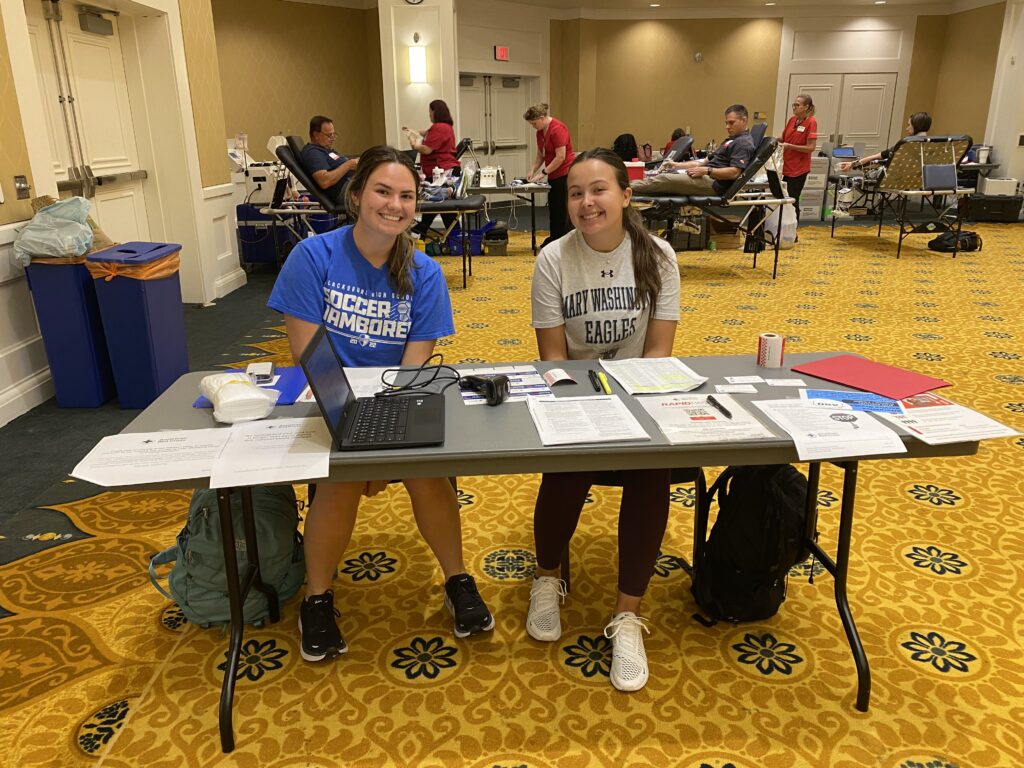Blood drive hosted by UMW Red Cross during Sickle Cell Awareness Month exceeds turnout expectations
3 min read
Madison Mayes and Sabrina Perez checking in donors at Red Cross Blood Drive | Photo courtesy of Harriet King
by MATEO GUTIERREZ
Staff Writer
On Sept. 18, the UMW Red Cross Student Organization partnered with the Red Cross to host a blood drive in the University Center Chandler Ballroom from 10 a.m.–5 p.m. in honor of September being Sickle Cell Awareness Month.
This month is a time used to educate the public about the genetic disorder and how vital blood donations are in improving the lives of those affected.
In response to the drive collecting 51 units of blood, Executive Director of the Rappahannock Chapter of the Red Cross Patricia Wolfrey said, “The goal was to collect 29 units so The Red Cross considers the drive to have been extremely successful.”
Sickle cell disease is a blood-borne, lifelong illness with no cure that affects approximately 100,000 people in the U.S. The disease disproportionately affects African Americans and people of African descent, with the disease affecting one out of every 365 African American babies.
“It’s important to get a wide demographic of blood donors for our drives because a large percentage of people with sickle cell anemia are ethnic and they get more benefit from blood transfusions from people of their own ethnicity due to the make-up of the blood components,” said President of the UMW Red Cross Organization Harriet King, a junior biochemistry major.
Sickle cell disease primarily affects hemoglobin, the protein that is in red blood cells that are responsible for carrying oxygen throughout the body. As a result, people who suffer from the disease have abnormal hemoglobin, which causes their red blood cells to become rigid and assume a crescent or sickle shape. These misshapen cells can lead to a range of health problems, including severe pain, anemia, organ damage and a shortened lifespan. Because of this, those who live with it will often require frequent blood transfusions to alleviate their symptoms and improve their overall health.
One of the Red Cross’ primary initiatives is blood drives, which provide a lifeline for patients, as they play a crucial part in managing the symptoms and pains associated with the disease.
During a Red Cross blood drive, individuals from all walks of life come together to offer aid to those in need. For people with the disease, these donations can improve their lives and even provide life-saving help. Transfusions of healthy red blood cells help to replace the sickle-shaped cells, improving oxygen flow and reducing the risk of complications.
The Red Cross often collaborates with student organizations on college campuses to host blood drives; in this case, it was UMW’s Red Cross Student Organization.
These events serve a dual purpose: They help to raise the nation’s blood supply while simultaneously educating young adults about sickle cell disease and the importance of regular blood donations.
While the event brings together students, faculty and local community members to donate blood and learn more about sickle cell disease, the impact of these blood drives extends far beyond the college campus; they provide a tangible way for individuals to make a positive impact on the lives of those with the disease, creating a sense of community and shared responsibility.
“I was very surprised at the turn out, the overall goal was exceeded and there were many walk-ins aside from the individuals who signed up prior to the event,” said Sabrina Perez, a sophomore biomedical sciences major who volunteered at the blood drive.
Social media campaigns, community outreach and collaborations all contribute to spreading awareness about sickle cell disease and the importance of blood donations. In September, the Red Cross often highlights the statistics of individuals with the disease who have been positively affected by blood transfusions. They also provide personal stories about how those affected cope with the disease, making it more personable and encouraging more people to participate in blood drives.
While Sickle Cell Awareness Month serves as a concentrated effort to promote awareness and blood donation, the need for support and donations persists year-round. Individuals with sickle cell disease rely on a consistent supply of blood to manage their condition and maintain a good quality of life.


